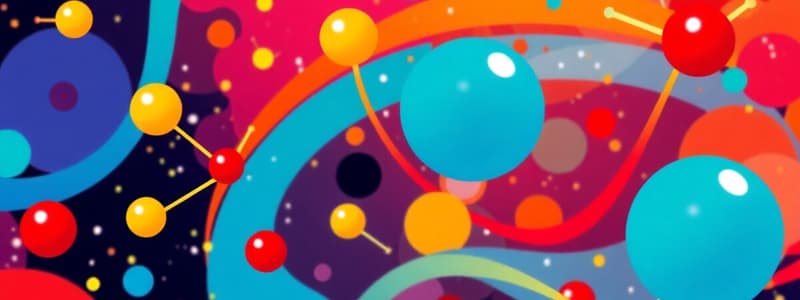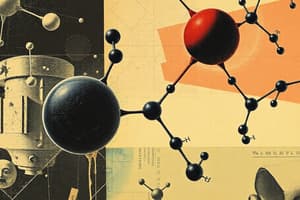Podcast
Questions and Answers
What characterizes ionic bonds?
What characterizes ionic bonds?
- They occur when electrons are completely transferred between atoms. (correct)
- They involve the sharing of electrons between atoms.
- They occur between nonmetals only.
- They involve partial charges rather than complete charges.
Which statement correctly describes the nature of reactants in a chemical reaction?
Which statement correctly describes the nature of reactants in a chemical reaction?
- Reactants are the substances formed at the end of a reaction.
- Reactants are always in gaseous state.
- Reactants are products that do not change during the reaction.
- Reactants undergo a change during the chemical reaction. (correct)
Which molecular shape corresponds to four regions of electron density around a central atom?
Which molecular shape corresponds to four regions of electron density around a central atom?
- Angular
- Linear
- Trigonal planar
- Tetrahedral (correct)
What does the periodic table help predict about elements?
What does the periodic table help predict about elements?
Which trend is generally observed across a period in the periodic table?
Which trend is generally observed across a period in the periodic table?
What determines the atomic number of an atom?
What determines the atomic number of an atom?
Which statement accurately distinguishes between elements and compounds?
Which statement accurately distinguishes between elements and compounds?
What is a characteristic feature of covalent bonds?
What is a characteristic feature of covalent bonds?
What role do valence electrons play in chemical bonding?
What role do valence electrons play in chemical bonding?
What type of bond results from the transfer of electrons between atoms?
What type of bond results from the transfer of electrons between atoms?
In the periodic table, elements in the same group share what characteristic?
In the periodic table, elements in the same group share what characteristic?
What is the primary component of a molecular formula like H₂O?
What is the primary component of a molecular formula like H₂O?
Which of the following statements is true about isotopes?
Which of the following statements is true about isotopes?
Flashcards
Atom
Atom
The smallest unit of an element that retains the chemical properties of that element. It is made up of a nucleus containing protons and neutrons, surrounded by electrons.
Proton
Proton
A subatomic particle found in the nucleus of an atom. It carries a positive (+) charge and determines the element's atomic number.
Electron
Electron
A subatomic particle that orbits the nucleus of an atom. It carries a negative (-) charge and is involved in chemical bonding.
Neutron
Neutron
Signup and view all the flashcards
Atomic Number
Atomic Number
Signup and view all the flashcards
Isotope
Isotope
Signup and view all the flashcards
Ionic Bond
Ionic Bond
Signup and view all the flashcards
Covalent Bond
Covalent Bond
Signup and view all the flashcards
Molecular Shape
Molecular Shape
Signup and view all the flashcards
Chemical Reaction
Chemical Reaction
Signup and view all the flashcards
Balancing Chemical Equations
Balancing Chemical Equations
Signup and view all the flashcards
Study Notes
Atomic Structure
- Atoms are the fundamental units of matter, incredibly small, and composed of a nucleus containing protons and neutrons, surrounded by electrons.
- Protons have a positive charge, electrons have a negative charge, and neutrons are neutral.
- The number of protons defines the atomic number and thus, the element.
- Atoms of the same element can have varying numbers of neutrons, creating isotopes. Isotopes have the same chemical properties but different masses.
- The nucleus is central, extremely small compared to the overall atom size, and holds protons and neutrons.
- Electrons orbit the nucleus in specific energy levels (shells). Outermost electrons (valence electrons) are crucial for chemical bonding.
- Electron distribution follows quantum rules, affecting the atom's chemical behavior.
Molecules
- Molecules form when two or more atoms chemically combine through either ionic or covalent bonds.
- Ionic bonds result from the complete electron transfer between atoms, forming oppositely charged ions that attract.
- Covalent bonds happen when atoms share electron pairs to achieve stable electron configurations.
- Molecular shapes (e.g., linear, angular, trigonal planar, tetrahedral) depend on bonding arrangements.
- Molecular properties depend on their shape and atomic interactions.
Chemical Reactions
- Chemical reactions involve breaking and forming chemical bonds, transforming reactants into products.
- Reactants are the initial substances, and products are the newly formed substances.
- Chemical equations represent reactions, showing reactants, products, and the correct number of moles using coefficients. Balancing chemical equations maintains mass conservation.
The Periodic Table
- The periodic table organizes elements by increasing atomic number, showing similar properties in vertical groups (columns).
- Elements in the same group share similar outermost electron configurations and thus, similar chemical properties.
- The periodic table is useful for organizing and predicting element behavior, including periodic trends like decreasing atomic radius across a period.
Studying That Suits You
Use AI to generate personalized quizzes and flashcards to suit your learning preferences.




